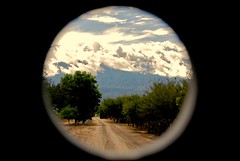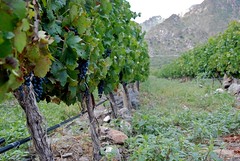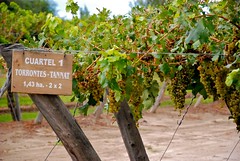For more information visit Aaron’s wineblog Vino e Vita, or contact AA@aaepstein.com.

My first post comes direct from Cafayate, Salta, the source not only of some of Argentina's best (and unknown) wines but also of its most impressive landscapes. In the two days I've been here I have honestly been torn about whether my time is better spent tasting wine or taking photographs.
With an average vineyard altitude of almost 5,500 feet above sea level and as many cactus as grapevines, the terrain here in Cafayate is like no other wine producing region in the world. The high altitude, desert climate, and drastic temperature contrast between daytime highs and nighttime lows result in concentrated, idiosyncratic wines that reflect the unique geology of the land as well as the artistry of the local winemakers. I must say that even after almost a year and a half tasting wine in Argentina, I have been impressed since I got off the plane in Salta.
While the wines from this region have only begun to emerge on the international scene in the past 5 years or so, leading the way are the those made from the Torrontés grape which has quickly come forth as Argentina's emblematic white varietal, with the undisputed best coming from the region of Salta and more specifically Cafayate. More and more established producers in Mendoza are buying grapes from here, and slowly but surely Torrontés is entering the consciousness of wine consumers around the world. So let me tell you a bit about it.
Recent studies show that Torrontés is related to Malvasia, a grape that is widely planted in both Italy and Spain, as well as Portugal where it is used in the production of the sweet wine Madeira. While nobody's exactly sure how it got down this far south there are now three varieties of Argentine Torrontés: Torrontés Riojano, Torrontés Sanjuanino, and Torrontés Mendocino, each of which is named after a region of Argentina (La Rioja, San Juan, and Mendoza). Of these three, Torrontés Riojano is by far the most common.
Torrontés is best known for its fresh, floral aromas, although in the warm regions where it seems to grow best it does run the risk of a high alcohol content which can lead to added weight and some heat on the palate. I often get tropical fruit on the nose as well as grassy notes similar to those normally associated with Sauvignon Blanc. This morning I had the pleasure of visiting Finca Las Nubes here in Cafayate, owned and run by the producer of one of my favorite Torrontés bottlings, José Luis Mounier. It was the first time I've had his 2008 Torrontés, which I found to be refreshing, perfectly balanced, nicely acidic, and with a alluring bouquet full of pineapple and spring flowers. If it were bottled as a perfume, well, it would be hard to keep me away from the woman wearing it.
I've also been quite impressed by the Laborum Torrontés produced by my new friends at Bodegas El Porvenir de los Andes, which is not surprising as it was their red wines that blew me away when I tasted them in Mendoza several months ago and inspired me to visit Cafayate in the first place. It's not an exaggeration to say that to my palate El Porvenir is making some of the best wine in Argentina, and having now visited their vineyards and winery I will be a loyal fan for life. Their wines are deeply concentrated and lushly textured, with fruit bursting out of the glass along with attractive notes of earth that truly do evoke the mountains surrounding the property. I'll be posting some more detailed tasting notes at the end of my trip here, but for the moment let's just say that the loving care in both vineyard and cellar shine through in everything they put their hands on. Winemaker Luis Asmet is a genius, and the expertise of consulting enologist Isabel Mijares, "flying winemaker" and confederate of renowned consultant Michel Rolland, gives the wines a depth and character that while distinctly Salteño provides a context well beyond the confines of the new world.
Unfortunately you can't taste the wines virtually, but I hope the below photos help you get a feel for the place.










No comments:
Post a Comment